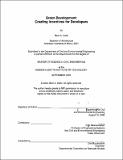| dc.contributor.advisor | Fred Moavenzadeh. | en_US |
| dc.contributor.author | Harik, Marc A. (Marc Adel), 1979- | en_US |
| dc.contributor.other | Massachusetts Institute of Technology. Dept. of Civil and Environmental Engineering. | en_US |
| dc.date.accessioned | 2009-10-01T16:03:08Z | |
| dc.date.available | 2009-10-01T16:03:08Z | |
| dc.date.copyright | 2002 | en_US |
| dc.date.issued | 2002 | en_US |
| dc.identifier.uri | http://hdl.handle.net/1721.1/47914 | |
| dc.description | Thesis (S.M.)--Massachusetts Institute of Technology, Dept. of Civil and Environmental Engineering, 2002. | en_US |
| dc.description | Includes bibliographical references (leaves 100-105). | en_US |
| dc.description.abstract | With a slowly decaying environment, the development in the construction industry is steering towards sustainability. Researchers are aware of the need for an environmentally sound building technology; however, the maturity of the research in the fields of sustainable architecture and 'green' building design is not matched in practice. This is due to a rather limited research on the economical side of sustainable strategies and a lack of incentives to push developers and investors into a trend still perceived to be very expensive. The financial equation behind 'Green' development can be simplified by the comparison between the increase in initial investment and the life-cycle cost benefits, discounted on the duration of the project. The latter can be divided into two major groups; savings due to lower operations and maintenance costs and benefits due to increased indoor environmental quality. Both would be reflected in a higher asset value which is an incentive for developers and investors to build 'green'. The first part of this thesis will investigate two different approaches to create incentives for developers to build 'green'. First, it will analyze the role of the Federal Government and the impact of 'green' buildings on the economy. Then, it will evaluate 'green' strategies as separate investments within a construction project. However, previous studies have concluded that energy-efficiency savings do not always justify the initial investment due to ever decreasing energy prices in the United States. This will shift the focus on the value of productivity and health benefits. The second part of this thesis, through a critical review of previous studies, will attempt to associate specific building upgrades with tangible productivity increases and health benefits, in the context of commercial office development. The outcome would be analyzed in the framework of a certification system adapted to indoor environmental quality. In conclusion, a comparative case study will investigate the financial performance of a regular office development versus a 'green' version of the same project, emphasizing on the impact of the productivity and health benefits. | en_US |
| dc.description.statementofresponsibility | by Marc A. Harik. | en_US |
| dc.format.extent | 105 leaves | en_US |
| dc.language.iso | eng | en_US |
| dc.publisher | Massachusetts Institute of Technology | en_US |
| dc.rights | M.I.T. theses are protected by
copyright. They may be viewed from this source for any purpose, but
reproduction or distribution in any format is prohibited without written
permission. See provided URL for inquiries about permission. | en_US |
| dc.rights.uri | http://dspace.mit.edu/handle/1721.1/7582 | en_US |
| dc.subject | Civil and Environmental Engineering. | en_US |
| dc.title | Green development : creating incentives for developers | en_US |
| dc.type | Thesis | en_US |
| dc.description.degree | S.M. | en_US |
| dc.contributor.department | Massachusetts Institute of Technology. Department of Civil and Environmental Engineering | |
| dc.identifier.oclc | 51874019 | en_US |
